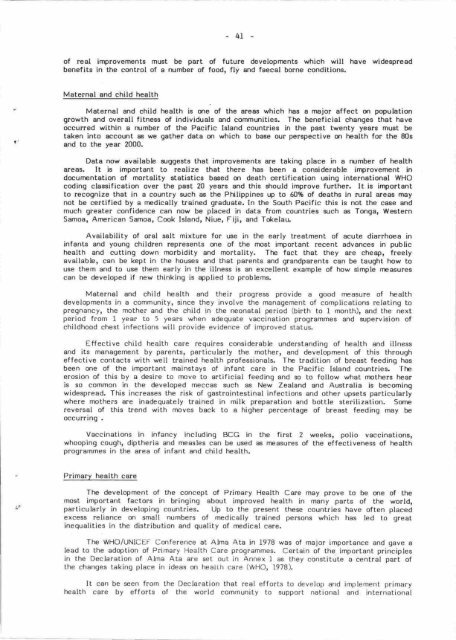Rt€@lll
Rt€@lll
Rt€@lll
Create successful ePaper yourself
Turn your PDF publications into a flip-book with our unique Google optimized e-Paper software.
-4r<br />
of real improvements must be part of future developments which will have widespread<br />
benefits in the control of a number of food, fly and faecal borne conditions.<br />
Maternal and child health<br />
Malernal and child health is me of the ereas which has e mejor affect m population<br />
growth and overall fitness of individuals and communities. The beneficial changes that have<br />
occurred within a rnrmber of the Pacific Island countries in the past twenty years must be<br />
taken into account as we gether data m which to base our perspective m health for the 80s<br />
and to the year 2000.<br />
Data now available suggests that improvenents are taking place in a rumber of health<br />
area8. It is important Lo realize that there has been a considerable inprovement in<br />
docurnentation of mortality statistics based m death certification using international WHO<br />
coding classification over the past 20 years and this should improve further. It is important<br />
to recognize that in a country such es the Philippines up to 60% of deaths in rural areas may<br />
not be certified by a medically trained graduale. ln the South Pacific this is not the case and<br />
much greater confidence can now be placed in data from countries such as Tonga, Western<br />
Samoa, American Sarnoa, Cook lsland, Niue, Fiji, and Tokelau.<br />
Availability of oral salt mixture for use in the early treatment of acute diarrhoea in<br />
infants and young children represents sre of [he most imporLant recent advances in public<br />
health and cutling down morbidity and mortality. The fact that they are cheap, freely<br />
available, ean be kept in the houses and that parents and grandparents can be taught how to<br />
use them and to use them early in the illness is an excellent example of how simple ffEesureg<br />
can be developed if new thinking is applied to problems.<br />
Maternal and child health and their progress provide a good measure of health<br />
developments in a community, since they involve the management of complications relating to<br />
pregnancy, the mother and the child in the neonatal period (birth to I month), and the next<br />
period from I year to 5 years when adequate vaccination programmes and slpervision of<br />
childhood chest infections will provide evidence of improved status.<br />
Effective child health care requires considerable understanding of health and illness<br />
and its management by parents, particularly the mother, and development of this through<br />
effective contacts with well trained health professionals. The tradition of breast feeding has<br />
been one of the important mainstays of infant care in Lhe Pacific Island countries. -fhe<br />
erosion of this by a desire [o move to arlificial feeding and so to follow what npthers hear<br />
is so eommon in the developed meccas such as New Zealand and Australia is becoming<br />
widespread. This increases the risk of gastrointestinal infections and other upsets particularly<br />
where mothers are inadequately trained in milk preparation and bottle sterilization. Sorne<br />
reversal of this trend with moves back to a higher percentage of breast feeding may be<br />
occurring .<br />
Vaccinations in infancy including BCG in the f irst 2 weeks, polio vaccinations,<br />
whooping cough, diptheria and measles can be used as measures of the effectiveness of health<br />
programmes in the area of infant and child heallh.<br />
Primarv health care<br />
The development of lhe concept of Primary Health Care may prove to be me of the<br />
most important factors in bringing about improved health in many parts of the world,<br />
particularly in developing countries. Up to the present these countries have often placed<br />
exeess reliance on small numbers of medically trained persons which has led to great<br />
inequalities in the distribution and quality of medical care.<br />
The WHO/UNICEF Conference at Alma Ata in 1978 was of major importance and gave a<br />
lead to the adoption of Prirnary Heallh Care programmes. Certain of the important principles<br />
in the Declaration of Alma Ata ane set out in Annex I as Lhey constitute a central part of<br />
the changes taking place in ideas on health care (WHO, 1978).<br />
It can be seen from the Declaration that real efforts to develop and implemenl primary<br />
health care by efforts of the world comrnunity to support national and in[ernational














![R]€@lll](https://img.yumpu.com/7594335/1/175x260/reurlll.jpg?quality=85)
